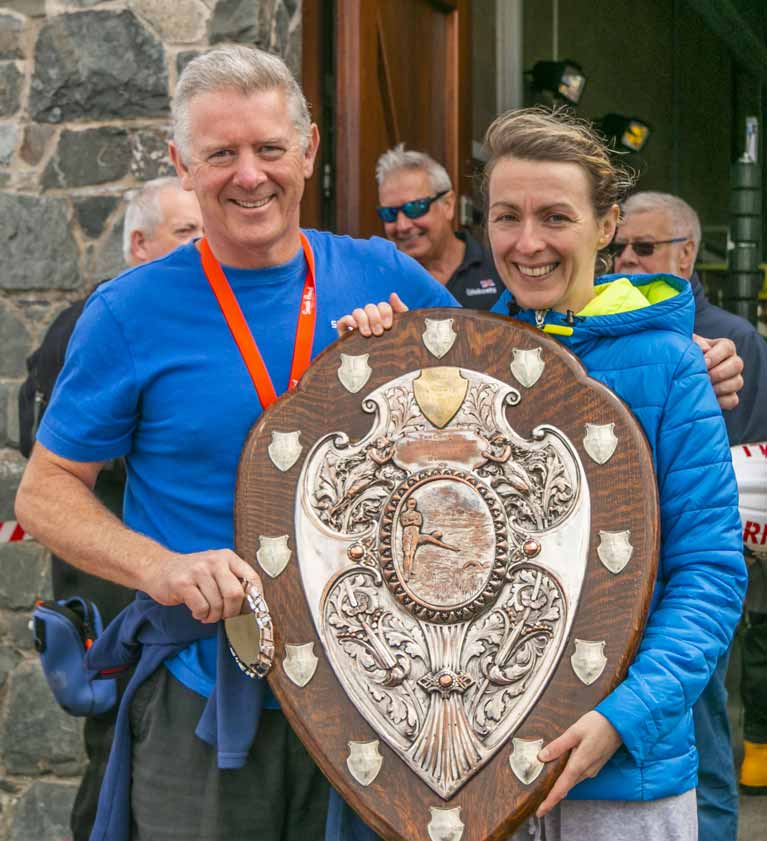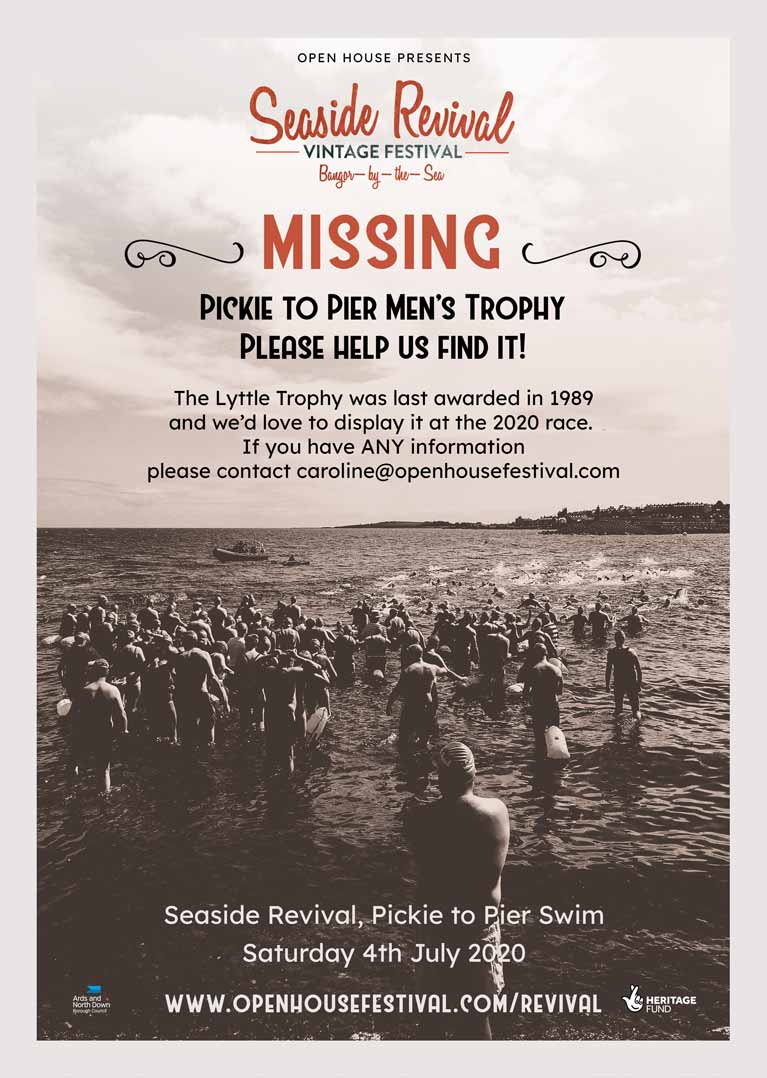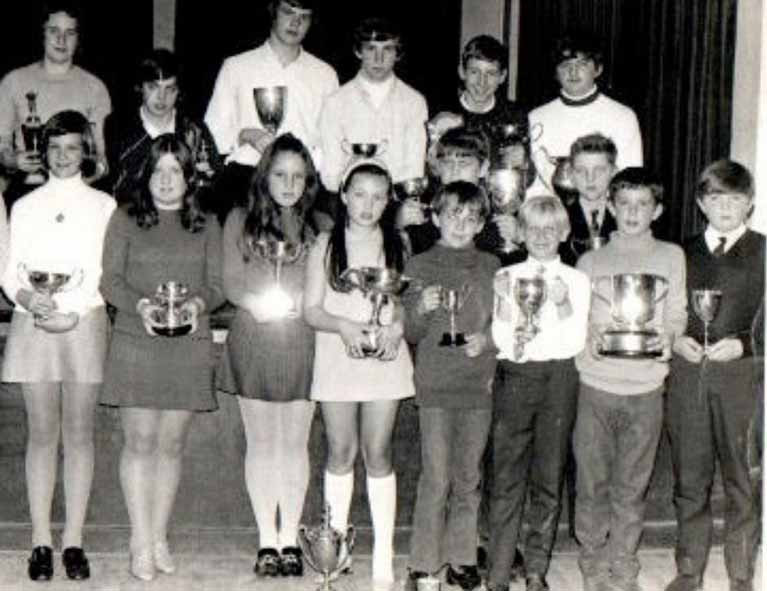Displaying items by tag: Bangor Bay
From Skippingstone Beach on the west side of Bangor Bay on Belfast Lough to the RNLI slipway in the Harbour is 800 metres and last week 200 swimmers raced that distance in the swim called the 'Pickie to Pier' named when it began back in 1910. It was run until 1989 and resurrected in 2019, then suspended during the Pandemic, only to be held again last year.
Pickie was the name of the open-air swimming pool near Skippingstone, long since demolished and in those days, there wasn’t the comfort of accompanying boats, kayaks and paddle boards for safety. One old hand said they just raced across the Bay to the Pier and that was that!
 At the Pickie to Pier finish
At the Pickie to Pier finish
The 200-strong group was made up of around 60% female and 40% male. The first four finishers were all women. First was Jessika Robson who won last year, in 9 minutes 15 seconds. Second was Jessika’s sister, Holly just 10 seconds later to be followed by Sian Clements in 9min 45sec.
The event drew large crowds and is no doubt now an established popular part of the Seaside Revival organised by Open House Festival, a charitable organization working towards the regeneration of Bangor.
Pickie to Pier Swim in Bangor Bay is Resurrected
Last Saturday (10th July) saw the resurrection of the famous Pickie to Pier swim in Bangor Bay after its cancellation last year due to Covid. Pickie is the previous site of the original sea water swimming pool on the west side of the Bay, which was demolished in the late 1980s to be replaced by a heated indoor pool, and the Pier is the old North Pier, now named Eisenhower Pier in memory of June 1944 when General Eisenhower inspected American troops gathered in Belfast Lough.
The 2019 event was held after a 30-year absence.
First home and taking the Women’s title was Jessika Robson in just seven minutes, followed by Gary Robinson winning the men’s section for the second time in a row.
 Jessica Robson centre, first Woman in the Pickie to Pier race with Gary Robinson, first Man and (left) Caroline McCoubrey Seaside Revival Co-ordinator and (right) Alan Whyte, Ballyholme YC
Jessica Robson centre, first Woman in the Pickie to Pier race with Gary Robinson, first Man and (left) Caroline McCoubrey Seaside Revival Co-ordinator and (right) Alan Whyte, Ballyholme YC
As told in Afloat.ie in January last year, the swim to the pier pre-dates the Bangor swimming club – the 18th annual swim was organised by Donegall Amateur Swimming Club based in Belfast IN 1910. But the Men’s trophy went missing and has never been found.
The Swim organisers from the Seaside Revival Vintage Festival said; “We're still grinning from ear to ear after yesterday's epic Pickie to Pier Swim. So many smiles, and whoops and cheers of encouragement for the 200 intrepid swimmers who took part in our 2021 Pickie to Pier Swim. The sun shone, the water was calm and clear, and the swimmers and spectators were all very happy people”.
 RNLI Bangor after duty at the Pickie to Pier swim.jpg
RNLI Bangor after duty at the Pickie to Pier swim.jpg
The swimmers swam the 800m course from Skippingstone Beach beside Pickie, to the RNLI slipway at Eisenhower Pier and were sent off and greeted at the finish by huge crowds of spectators.
 Paddle board safety volunteers at the Pickie to Pier swim
Paddle board safety volunteers at the Pickie to Pier swim
Seaside Revival thanked Alan Whyte and Ballyholme Yacht Club, Marina Manager Kevin Baird and all the volunteers who secured the swimmers on boats, kayaks and paddle boards; the RNLI, and Spar Ballyholme, Spar Gransha Road and Spar Abbeyhill for their support.
Bangor Coastguard Rescue Team Discover Boat on Rocks
Bangor Coastguard Rescue Team didn't have far to travel to answer a report today (21st June) of a vessel aground on the rocks at Brompton on the opposite side of Bangor Bay from the Belfast Lough station.
Winds were strong from the North with rough seas and breaking waves.
The team managed to contact the owner, who arrived a short time later.
All belongings, engine and fuel were removed from the vessel by the owner, and the hope was that it could be refloated at the next high tide.
Hunt is on for Bangor Bay's Missing 'Pickie to Pier' Swim Trophy
Today you couldn’t swim across Bangor Bay on Belfast Lough without skirting the Marina but from 1910 till the 80s the ‘Pickie to Pier’ annual sea swim saw many participants taking part in the 650-metre race from Skippingstone Beach, beside what is now Pickie Fun Park, to the then North Pier, now named the Eisenhower Pier, and back.
Now, in its Seaside Revival programme, the Open House Festival which runs in August every year in Bangor, the Pickie to Pier race is being held again, (in 2020 it is on July 4th) but sadly, the men’s prize, the Lyttle Trophy is missing! The ladies are lucky, however, as their prize is still intact. It is named the Connor Shield after a well-known old Bangor family.
So, the hunt is on for that trophy. Local businessman David McCullough won the race in the late 1960s when he was around 12 years old and remembers the trophy had three handles.
 Pickie to Pier swim winners 2019 Julie McCabe and Gary Robinson
Pickie to Pier swim winners 2019 Julie McCabe and Gary Robinson
The swim to the pier pre-dates the Bangor swimming club – the 18th annual swim was organised by Donegall Amateur Swimming Club based in Belfast. By the time Bangor ASC was formed, there were inter-club races to the pier featuring Wellington, New Alliance and Northern swimming clubs. BASC swam the route weekly, and the Pickie to Pier race carried on through two world wars but met its demise in the late 1980s when a new heated indoor pool was favoured to the freezing cold, jellyfish-laden waters of Bangor Bay.
According to one of the local librarians who has done some research, it is probable that 1918 was the 18th year of the race but no evidence that it started in 1910 could be found in the local press. The race did continue through WWII but there is a gap in the library reels from 1916 – 25 so those years cannot be checked. Generally, the race was run for individuals in a handicap system according to how good a swimmer they were – the faster you were, the longer you had to wait before starting off. There was also a team event for the Gamble Memorial Trophy.
 Pickie to Pier poster appeal for the missing trophy
Pickie to Pier poster appeal for the missing trophy
Before Pickie Pool was built in 1931, gentlemen swam in that area and the ladies swam just below the large mansion called Seacourt in what was called ‘Ladies Bathing Place”.
Many people who did the race remember how cold it was, even in August; the horrors of being touched by the seaweed and stinging jellyfish as well as the distance, all presented a huge challenge. One of the competitors remembers the coal boat leaving harbour during the race, creating chaos. But what amounts to a questionable memory is that of a competitor who did the swim with a bottle of Olde English (an American malt liquor) in one hand and a Rod Stewart album in the other!
So if you can help please contact Caroline McCoubrey [email protected]





























































